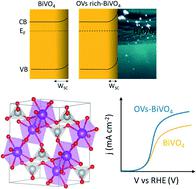当前位置:
X-MOL 学术
›
Sustain. Energy Fuels
›
论文详情
Our official English website, www.x-mol.net, welcomes your
feedback! (Note: you will need to create a separate account there.)
The role of oxygen vacancies in water splitting photoanodes
Sustainable Energy & Fuels ( IF 5.0 ) Pub Date : 2020-09-28 , DOI: 10.1039/d0se01305f Roser Fernández-Climent 1, 2, 3, 4 , Sixto Giménez 1, 2, 3, 4 , Miguel García-Tecedor 1, 2, 3, 4
Sustainable Energy & Fuels ( IF 5.0 ) Pub Date : 2020-09-28 , DOI: 10.1039/d0se01305f Roser Fernández-Climent 1, 2, 3, 4 , Sixto Giménez 1, 2, 3, 4 , Miguel García-Tecedor 1, 2, 3, 4
Affiliation

|
Photoelectrochemical water splitting has become one of the most reliable solar-energy conversion technologies for clean hydrogen production. In the race of developing and understanding new semiconducting materials for this application, several studies have been focused on the role of oxygen vacancies, which are known to be defects with a high impact on the final optical and electrical properties of the photoelectrodes. These oxygen defective states can introduce either favorable or detrimental pathways to the overall PEC performance. The present topical review aims to summarize the role of oxygen vacancies in four of the most studied semiconducting thin film oxides (BiVO4, Fe2O3, TiO2 and WO3) as photoanodes for solar water splitting.
中文翻译:

氧空位在水分解光阳极中的作用
光电化学水分解已成为清洁氢气生产中最可靠的太阳能转化技术之一。在开发和理解用于这种应用的新型半导体材料的竞赛中,数项研究集中在氧空位的作用上,氧空位是已知的缺陷,对光电极的最终光学和电学性能有很大影响。这些氧缺陷状态可以为总体PEC性能引入有利或有害的途径。本主题综述旨在总结氧空位在四种研究最多的半导体薄膜氧化物(BiVO 4,Fe 2 O 3,TiO 2和WO 3)中的作用。)作为用于太阳能水分解的光阳极。
更新日期:2020-11-03
中文翻译:

氧空位在水分解光阳极中的作用
光电化学水分解已成为清洁氢气生产中最可靠的太阳能转化技术之一。在开发和理解用于这种应用的新型半导体材料的竞赛中,数项研究集中在氧空位的作用上,氧空位是已知的缺陷,对光电极的最终光学和电学性能有很大影响。这些氧缺陷状态可以为总体PEC性能引入有利或有害的途径。本主题综述旨在总结氧空位在四种研究最多的半导体薄膜氧化物(BiVO 4,Fe 2 O 3,TiO 2和WO 3)中的作用。)作为用于太阳能水分解的光阳极。











































 京公网安备 11010802027423号
京公网安备 11010802027423号